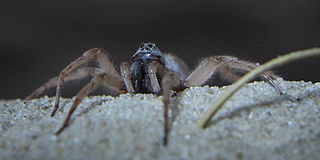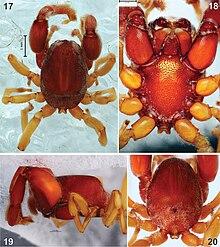
Ground spiders comprise Gnaphosidae, the seventh largest spider family with over 2,000 described species in over 100 genera distributed worldwide. There are 105 species known to central Europe, and common genera include Gnaphosa, Drassodes, Micaria, Cesonia, Zelotes and many others. They are closely related to Clubionidae. At present, no ground spiders are known to be seriously venomous to humans.

Heliophanus is a genus of the spider family Salticidae. Most of the almost 170 described species occur in Africa, with many others found in the Palearctic region from Europe to Japan.

Phlegra is a genus of jumping spiders that was first described by Eugène Louis Simon in 1876. The name is a reference to a mythical location in both Greek and Roman mythology.

Hogna is a genus of wolf spiders with more than 200 described species. It is found on all continents except Antarctica.

Zelotes is a genus of ground spiders that was first described by J. Gistel in 1848.

Allocosa is a spider genus of the wolf spider family, Lycosidae. The 130 or more recognized species are spread worldwide.

Olios is the largest genus of huntsman spiders, containing 166 species. They are found throughout the world, with most species occurring in hot countries. The genus was first described by Charles Athanase Walckenaer in 1837.

Nomisia is a genus of ground spiders that was first described by R. de Dalmas in 1921.

Heriaeus is a genus of crab spiders that was first described by Eugène Louis Simon in 1875.









